What is the full form of WBCWBC: White Blood CellWBC stands for White Blood Cell. It is also called leukocyte or white blood corpuscle. It is a cellular component of the blood. It has a nucleus but does not have hemoglobin like RBCs (red blood cells). Its main role is to protect the body from infections and diseases, e.g. it produces antibodies to destroy the infectious agents like bacteria, viruses, germs, etc. WBCs are produced in the bone marrow and stored in blood and lymphatic tissue. They are classified into two main groups: granulocytes and agranulocytes (non-granulocytes or non-granular). As the name indicates, the granulocytes have granules in their cell cytoplasm and have a multi-lobed nucleus. They are of three types: Neutrophils, Eosinophils, and Basophils. The non-granulocytes do not have granules in their cell cytoplasm and have non-lobular nuclei. They are of two types: Lymphocytes and Monocytes. Granulocytes are described as follows:Neutrophils: They possess a single, multi-lobed nucleus. They are also the most abundant type of WBCs in the blood circulation, e.g. 40-70% of the WBCs in the bloodstream or 2000 to 7500 cells per mm3 in the blood. They are the first line of defence of our body as they quickly reach the site of infection or injury than other types of WBCs. Neutrophils attach themselves to the wall of blood vessels in order to block the entry of germs into the blood through a cut or infection. They are phagocytes as they kill germs thorough phagocytosis, e.g. first they ingest germs then they kill and digest them. They have a chemical in their granules that they release to kill the pathogens. See the image below: 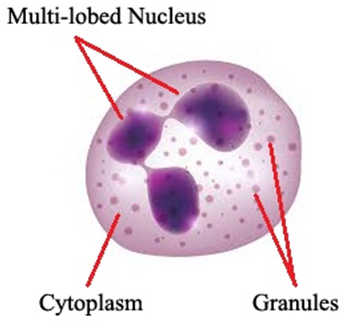
Eosinophils: They have a double-lobed, U-shaped nucleus. They are less abundant WBCs, e.g. they account for less than 8% of the circulating while blood cells (60-400 cells per mm3 of the bloodstream). They particularly fight the parasitic infections and allergies. Eosinophils are also phagocytic white blood cells. They have large granules that contain chemicals to destroy the pathogens. Eosinophils are commonly found in the connective tissues of the intestine and stomach. See the image below: 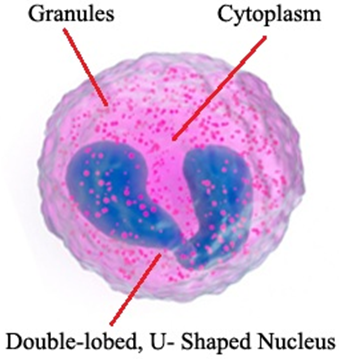
Basophils: Basophils are the least abundant type of the white blood cells, e.g. they account for less than 1 to 2 percent of leukocytes in the bloodstream. Like other granulocytes, they also have multi-lobed nucleus and granules in their cytoplasm. They have histamines and heparin in their granules. Heparin thins the blood and prevents blood clotting. Histamine dilates the blood vessels that promotes blood flow and helps white blood cells quickly reach the site of injury or infection. These cells have surface receptors that bind allergy-specific antibodies. When these antibodies encounter a triggering substance, the cells release histamine to initiate body's allergic response. See the image below: 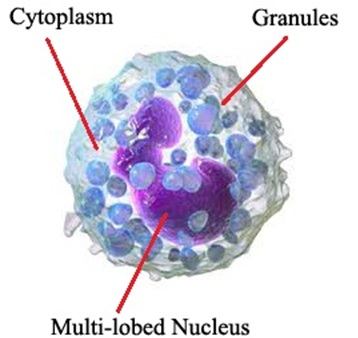
Agranulocytes are described as follows:Lymphocytes: They are small, round cells that contain a large nucleus and a small amount of cytoplasm. They are the second most abundant type of WBCs in the bloodstream, e.g. 20 to 40 percent of all white blood cells (1300 to 1400 lymphocytes per mm3 of the blood). They are mostly found in lymphatic tissues including the spleen, tonsils and lymph nodes. Lymphocytes are mainly of two types: B lymphocytes and T lymphocytes. B lymphocytes: These cells produce antibodies that bind to infected cells or microbes. It neutralizes the infected microbes or marks them out for attack by T lymphocytes. T lymphocytes: These cells help recognize infectious invaders and activate other types of WBCs. Cytotoxic T cells and Natural Killer Cells are also the types of T lymphocytes that destroy abnormal cells like cancer cells, virus-infected cells etc. See the image below: 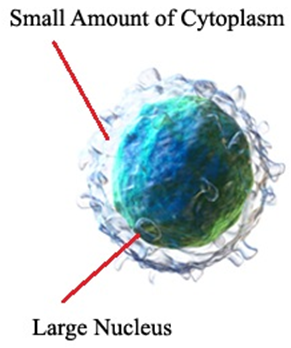
Monocytes: They are the largest type of WBCs and usually account for 1 to 10 % of WBCs (leukocytes) in the bloodstream. They have few granules in their cytoplasm and their nucleus may be kidney or bean shaped. They are versatile cells as they differentiate into macrophages when they enter into body tissues from the bloodstream. The macrophages engulf and kill infectious organisms, particularly bacteria. They also release signaling chemicals to attract and send the other WBCs to the site of infection. They also help T cells to respond to infections. See the image below: 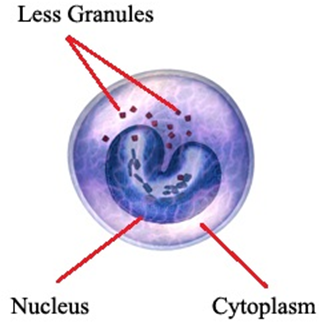
Next TopicFull Form
|
 For Videos Join Our Youtube Channel: Join Now
For Videos Join Our Youtube Channel: Join Now
Feedback
- Send your Feedback to [email protected]
Help Others, Please Share










